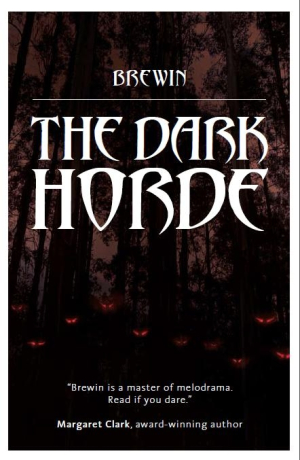The Dark Horde
“A bleeding, burning, mutilated machine of merciless destruction” can ruin anyone’s day, as a character named Henry discovers in this novel by Andrew Drage (a.k.a. Brewin). In The Dark Horde, the constables, students, and other residents of the little Melbourne suburb of Howqua Hills suffer through four such very ruinous days in April 1989.
The Dark Horde is horror on a personal, small-community level. When evil proclaims that “your extinction is imminent,” it need not announce it from hovering spaceships or broadcast it on all channels for the entire world to see and hear. If anything, it is more terrifying if you hear it inside your head or see it standing before you in your living room, claws and jaws extended and dripping venom and blood on the carpet. That is the point of view the author takes in this gruesome, gory, gut-twisting story of unspeakable evil unleashed on unsuspecting townsfolk on the edge of the outback.
How the slavering squad of monsters who torture, kill, rape, and eat people (in that necrophilic order) comes to Howqua Hills is at least half the story, and to reveal that here would be a great disservice to both author and readers. Brewin does not hold back in his description of the terrifying and stomach-turning activities of these disgusting creatures who, at various times, feast on men, women, and children.
The Dark Horde is not an easy book to read, and not merely because of the gruesome invaders who “fornicate with the human dead” or hunt down little children and their cuddly pets. There is a lot of foul language, and there are some very unsettling scenes that take place in that most terrifying of all settings—nightmares. Two of the main characters, police Sergeant Brian Derwent along with a fourteen-year-old boy named Danny, are largely unsympathetic souls. The only likable characters perish in terrifying ways.
This is an uneven book. There are patches of true horror, but there are also entire sections that come about without preparation or explanation, notably those in which “The Venomed One” speaks. Brewin also has some very long passages about schoolboy bullying, domestic squabbling, and psychotherapeutic evaluations that meander and require the reader to supply the glue to fully integrate them into the story. The writing overall is competent if not inspired, and a few bridges would be appreciated, as the connections between the sergeant (Danny), a suspected Satan worshiper (Henry), and the evil that comes to Howqua Hills are not always evident or elegant.
Why the book is set in Australia and in 1989, let alone those four particular days in April of that year, is never explained. Nor is there any hint of what happens or is about to happen on day five. The story would have been much more powerful, threatening, and terrifying if set in the present, with the future left uncertain.
The Dark Horde terrifies and disgusts, often outrageously so, which seems to be the author’s primary goal. In that, Brewin has succeeded. Suffice it to say, this book is best read on an empty stomach, and by the light of day.
Reviewed by
Mark McLaughlin
Disclosure: This article is not an endorsement, but a review. The publisher of this book provided free copies of the book and paid a small fee to have their book reviewed by a professional reviewer. Foreword Reviews and Clarion Reviews make no guarantee that the publisher will receive a positive review. Foreword Magazine, Inc. is disclosing this in accordance with the Federal Trade Commission’s 16 CFR, Part 255.

